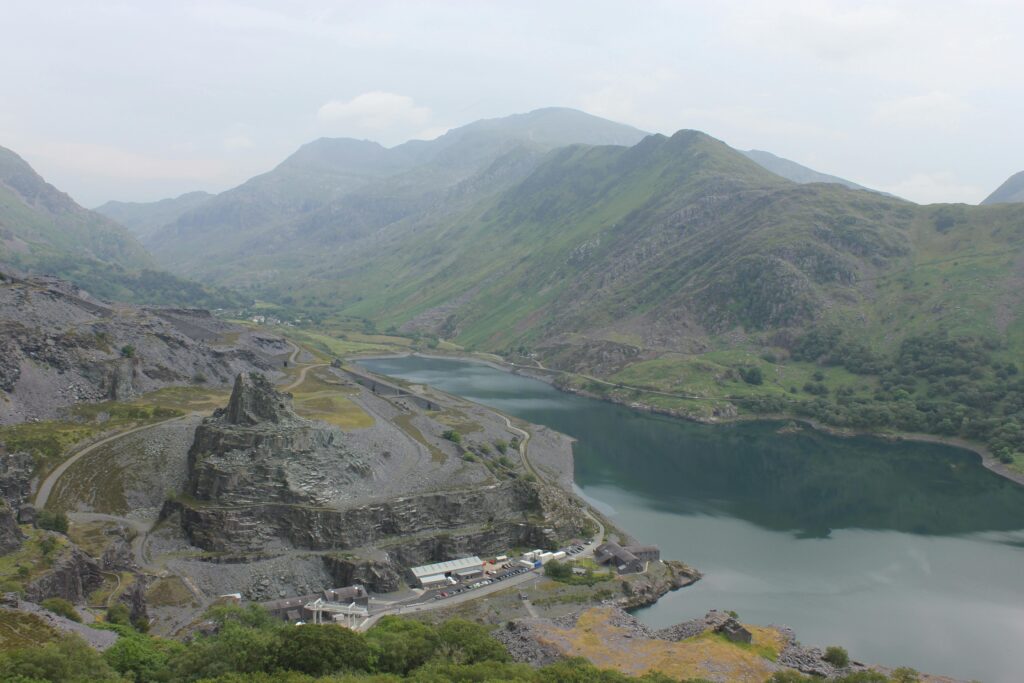Overview
Snowdonia, or Eryri in Welsh, is a mountainous region located in North Wales, renowned for its stunning natural beauty and rich cultural heritage. Covering an area of approximately 2,142 square kilometers (828 square miles), Snowdonia National Park is characterized by rugged mountains, lush valleys, tranquil lakes, and a dramatic coastline. Established in 1951, it is one of the largest and most visited national parks in the UK.

Key Features
Mountains
Snowdonia is dominated by its impressive mountain ranges, which include:
- Snowdon (Yr Wyddfa): The highest peak in Wales, standing at 1,085 meters (3,560 feet). Snowdon is a major attraction, offering various hiking routes to the summit, where visitors are rewarded with panoramic views of the surrounding landscape. The peak is often shrouded in mist, adding to its mystical allure.
- Crib Goch: A challenging ridge near Snowdon, known for its scrambly and exposed sections. It is a popular route for experienced hikers and climbers seeking a thrilling ascent.
- Tryfan: A distinctive peak with a characteristic jagged profile, standing at 917 meters (3,009 feet). It is renowned for its rugged terrain and is a favorite among climbers and hikers.
- Cadair Idris: A prominent peak in southern Snowdonia, reaching 893 meters (2,930 feet). The mountain offers several hiking trails, including the challenging route to its summit, which is said to offer spectacular views and legendary tales.
Lakes
Snowdonia is home to numerous picturesque lakes, each adding to the park’s charm:
- Llyn Tegid (Bala Lake): The largest natural lake in Wales, stretching over 4.5 kilometers (2.8 miles). It is popular for sailing, kayaking, and fishing.
- Llyn Padarn: A glacial lake near Llanberis, surrounded by stunning scenery and offering opportunities for boating and swimming.
- Llyn Cwellyn: A smaller but equally scenic lake situated at the foot of Snowdon, ideal for peaceful walks and nature watching.
Valleys and Glens
Snowdonia features beautiful valleys and glens that offer serene landscapes and outdoor activities:
- Ffestiniog Valley: Known for its slate mining heritage and dramatic scenery, the valley is home to the historic Ffestiniog Railway and the picturesque village of Blaenau Ffestiniog.
- Glyndŵr’s Way: A long-distance trail that traverses the park’s rolling hills and valleys, named after the 15th-century Welsh rebel leader Owain Glyndŵr.
Hiking and Climbing
Snowdonia is a premier destination for hiking and climbing, with a variety of trails and routes catering to different skill levels:
- Snowdon Horseshoe: A challenging circuit that includes the ascent of Snowdon and the ridges of Crib Goch and Y Lliwedd. It offers breathtaking views and technical scrambles.
- The Llanberis Path: One of the six main routes to the summit of Snowdon, this is the longest but considered the most gradual and suitable for beginners.
- The Miners’ Path: A scenic route that follows old mining paths and provides access to the beautiful lakes and mining relics in the area.
- The Watkin Path: Known for its steep and demanding ascent, it offers spectacular views of Snowdon’s south face and the surrounding countryside.
- The Rhinogydd: A less frequented range offering rugged terrain and solitude, ideal for adventurous hikers.
Wildlife and Nature
Snowdonia boasts a diverse range of flora and fauna, supported by its varied habitats:
- Flora: The park features heather moorlands, ancient woodlands, and alpine meadows. Rare plants such as the Snowdon lily and various orchids can be found in the area.
- Fauna: Snowdonia is home to a variety of wildlife, including red kites, peregrine falcons, and mountain ponies. The park’s woodlands and uplands also support species such as the Welsh mountain sheep and the elusive pine marten.
Cultural Heritage
Snowdonia has a rich cultural and historical background, with numerous sites of interest:
- Dolwyddelan Castle: A medieval castle ruin offering historical insights and scenic views of the surrounding landscape.
- Portmeirion: A unique village designed by Sir Clough Williams-Ellis, featuring eclectic architecture and beautiful gardens, situated near the park.
- The Slate Industry: Snowdonia’s slate mining heritage is celebrated in various museums and historic sites, reflecting the region’s industrial past.
Outdoor Activities
In addition to hiking and climbing, Snowdonia offers a range of outdoor activities:
- Cycling: The park has several mountain biking trails, including the Coed y Brenin Forest Park, which offers trails for all levels of cyclists.
- Water Sports: Lakes like Llyn Tegid and Llyn Padarn are popular for kayaking, paddleboarding, and sailing.
- Caving: The park features various cave systems, including the famous Ogof Ffynnon Ddu, one of the deepest caves in Wales.
Conservation and Sustainability
Snowdonia National Park is committed to preserving its natural and cultural heritage. Conservation efforts focus on maintaining the park’s landscapes, protecting wildlife, and promoting sustainable tourism practices. Visitors are encouraged to follow guidelines, such as respecting wildlife, staying on marked trails, and minimizing their environmental impact.
Conclusion
Snowdonia is a treasure trove of natural beauty, outdoor adventure, and cultural heritage. With its dramatic mountains, serene lakes, and diverse wildlife, it offers a rich experience for hikers, climbers, and nature enthusiasts. Whether exploring the rugged peaks of Snowdon and Tryfan or enjoying the tranquility of its lakes and valleys, Snowdonia provides a captivating and memorable destination for all who visit.